Amsted Digital’s IQ Series telematics module and Bogie IQ technology provide real-time location tracking and condition monitoring to support a cost-effective predictive maintenance regime.
Over the past five years, Amsted Digital Solutions has been rolling out its latest telematics gateway to support real-time location and condition monitoring of freight wagon fleets around the globe. The Bogie IQ technology is built around the company’s rugged IQ Series platform, which uses an encapsulated module mounted on the vehicle bogie to support a wide range of optional functionality.

Executive Vice President and COO Brad Myers explains that the IQ Series gateway is the company’s third-generation platform, following the T-Series launched in 2008-09 and the later E-Series introduced in 2016. The first IQ Series units went into revenue service in 2019 and operated successfully through the Covid pandemic, although he notes that the company had limited access to the devices during that time so early assessments were done remotely.
Since then, he reports, Amsted Digital has delivered ‘thousands’ of devices for vehicles operating in North America, Europe, Australia and South Africa, and is targeting installations in Brazil.
Simple and robust
The bogie-mounted telematics unit provides location tracking, load monitoring, brake slide event tracking, basic impact detection and wheelset condition monitoring from a single device, without the need to fit additional sensors on the vehicles.
Myers says the concept was initially developed for the Class I railroads in North America, with a particular focus on both cost and maintainability. ‘The more sensors customers have to put on, the higher the cost, both for the product and also for installation’, he explains. ‘And every time we introduce another sensor, that is another point of vulnerability for reliability issues in the field. Parallel to that was the sustainability aspect, with emerging concerns about battery life and disposal. We were quite cognisant of these concerns, not only from the cost standpoint but from a sustainability standpoint. So we have evolved a single gateway that contains everything that may be needed over a typical life of 7 to 15 years depending on the asset’s annual utilisation.’
The sealed unit incorporates a magnetometer, a three-axis low frequency accelerometer, a three-axis high frequency accelerometer and a microphone. ‘With combinations of these data types, our target is to create new features without having to add wireless sensors’, Myers says. ‘We do have the capability to add wireless sensors, as the IQ Series unit has an embedded Bluetooth low-energy chipset. But if we can do more with less, all the better.
‘That’s bucket one. Bucket two is the fact that we are a railcar company. Amsted has more than 140 years’ experience manufacturing wagon components — wheels, axles, bearings, bogies and castings. We are not just another IoT company looking to introduce a product to the rail sector. In fact we are the opposite: a rail company able to develop our own IoT applications.
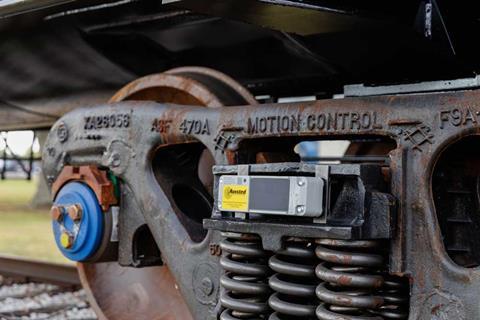
‘When our team developed the IQ Series gateway back in 2019, we were very targeted on detecting the maximum amount of oscillation or vibration from the wagon to try to characterise and classify different characteristics, such as wheelset health, brake slide events, load/empty state change, those kinds of things. The bogie is essentially the backbone of a wagon or freight car, if you will. That’s what led us to looking at mounting the unit on the bogie in a particular location and orientation, in order to extract those kinds of frequencies.
‘It is pretty inexpensive from a total adoption standpoint. The IQ Series is the telematics gateway, and Bogie IQ is a configuration where it gets mounted down on the bogie, to detect the kind of events I mentioned. A single gateway mounted on one bogie can give you almost everything for a single wagon, apart from wheelset health, where it can only monitor the wheelsets on that particular bogie. Customers that want full visibility across all-wheelsets would need to have two devices — one per bogie.
Asked whether the detection of load distribution status would be better with two devices, Myers says one IQ Series unit can determine a wagon’s load status change but there are features on Amsted Digital’s roadmap for more advanced data sets using Bogie IQ technology.
‘Mounting the gateway on the end of the bolster on a typical North American three-piece truck, we can measure the state change from empty and loaded based on the travel in the spring nest. The bolster moves up and down on the springs, so it’s more simplistic for us to identify a load/empty state change.
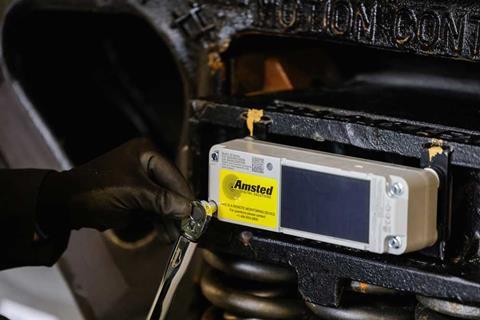
‘The European Y25 bogie has a very different suspension. So we have been demonstrating a similar technology using our IQ Series gateway with two big lessors and a private shipper. Tracking wheelset health and brake slide events is much the same, but for Europe we calculate the load status condition when the wagon is in motion, using the two accelerometers to determine whether it’s in a loaded or an empty condition. And then we back-calculate the mileage as loaded or empty, which provides greater insights into the utilisation of their assets without the need for additional wireless sensors.’
Maximising battery life
While some suppliers use vibration or thermal energy harvesting to power their telematics modules, Myers says Amsted Digital has opted for a ‘hybrid proprietary design’, using a rechargeable battery within the sealed module which is trickle-charged from a photovoltaic solar cell.
‘With any of these technologies the big question is, will they survive in the railroad environment?’, he asks. ‘And how often are you going to be able to access that wagon, if and when that part has an issue?’
Maintainability is a particular concern in North America, where freight cars can run for many thousands of kilometers in interchange service before returning ‘home’ for a maintenance cycle. Railroads faced with a wagon with a defect will simply replace the whole wheelset, and Myers says they ‘are not going to spend time to try to disassemble somebody’s unique power generator’. Conversely, there is no comparable ‘repair in place’ ecosystem in Europe, so the entities in charge of maintenance would have to find a suitable facility to deal with any out-of-course interventions.
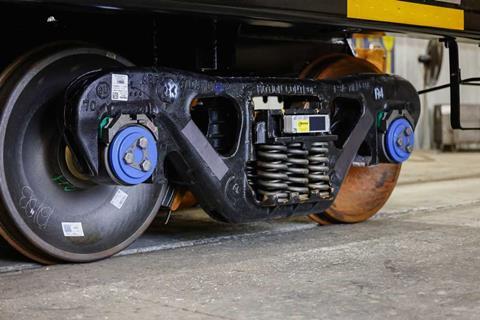
Myers says the typical device life for the IQ Series can be ‘anywhere between 7 and 15 years’, depending on the vehicle type and duty cycles. He notes that some wagons only do one trip a month, being in motion for perhaps 20% of their annual service, while others with a more intensive utilisation can be moving 50% to 60% annually.
He explains that the main power draw is when the unit is getting a GPS location fix or making a mobile phone call to report its status – whether that call is successful or not. Bogie IQ reports every 15 min when the vehicle is moving. While stationary, it shuts down and only reports every 12 h, after making one location report.
The system uses 4G mobile networks but has a 5G capability for forward compatibility. European applications also have a 2G fallback, ‘because the maturity of the 4G infrastructure in Europe is not quite there yet’. Amsted Digital works with a mobile virtual network operator, which in turn negotiates licenced access to many of the different carriers and frequencies needed in a given market.
‘Start/Stop events are a lot of what dictates how often we make a call or get a GPS fix — features related to wheel slide events or brake health’, Myers explains. ‘For example, a wagon’s wheelsets are considered healthy when there is no heartbeat. The moment that those wheelsets start to develop a heartbeat implies the sign of a defect. We monitor the change over time to track the degradation to provide customers optimal planning to reduce costs. We’re reporting every 15 min — we are not waiting until it hits a safety critical threshold, as that wouldn’t do anybody any good. The whole point is that we are giving predictive data.
‘Frequency is important — over a trip, whether a loaded or empty trip, you’re not going to get a false verified data point. It’s going to be validated wherever that tread defect is on that wheel. Defects are less than the size of a dime at the beginning; how many times does that defect hit the very top of the rail head at just the right point to give the maximum vertical impact? Because we monitor so frequently, we know we’re going to catch that wheelset and its health reading while moving back and forth over that rail head.
‘And then we send that data to the client. The customer determines the threshold at which they want to be proactive. We ask them what they think is appropriate to give them enough of a window to do the proper maintenance planning, versus waiting until it’s condemnable.
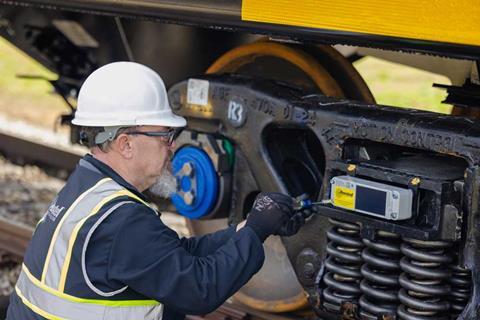
‘We give them enough visibility so they can plan ahead and shop the wagon or send out a mobile response unit. Or if it’s still sitting at a customer’s facility, go and address that before it ever gets moved again. That’s a lot of the value that the European market will get. But the North American market sees the same opportunity.’
Asked whether Amsted Digital gives its customers advice based on experience with other users, Myers says this is essentially focused on commodity type and vehicle utilisation. ‘It also partly depends on how much direct control a particular user has’, whether they are a shipper that owns or leases wagons, a leasing company or a train operator. That perspective will feed into their optimum maintenance practices.
User perspectives
Myers says Amsted Digital now has Bogie IQ applications across the rail ecosystem, from vertically integrated railways to leasing companies, for owned and leased vehicles operating on their own and other people’s tracks.
‘We started in North America, where the railroads are usually the first line of defence for maintenance on a railcar. When a railcar has a defect, that railroad wants to get that car fixed and through that repair in progress as quickly as possible. We wanted to make sure that we understood the key challenges, so that’s where we started. Then we moved to other operating railroads, short lines or smaller railroads and we worked with a couple of different lessors and private car owners. And then we looked at Europe, where operators don’t have quite the same degree of flexibility when it comes to dealing with a lot of maintenance interventions.’
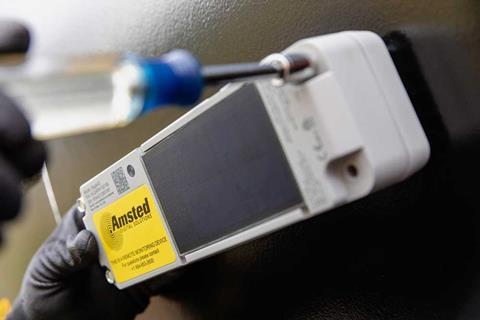
Asked who gets the status reports, Myers explains that the data from each vehicle ‘goes to whoever has the influence over the maintenance responsibility at the end of the day. If someone leases a wagon under a full service lease, they may not have responsibility for replacing the wheelset, so that data stream would probably go to the lessor. But if the lessee has maintenance responsibility, then they would want to be the ones to get the data to act on it.’
Driving efficiencies
As the rail sector moves towards more predictive maintenance globally, the critical questions are what to monitor, how frequently, and when is the right time to intervene. What is the optimum point in the cost cycle, between intervening too early or leaving it until it’s too late?
‘If you’re proactive, you don’t want to wait for the railroads to be the ones to remove the wheelsets’, says Myers. ‘That’s really the goal. Railroads and operators would rather keep the wagons moving as much as possible and not have to perform maintenance if they can avoid it.
‘I think the return on investment is very similar whether it’s Europe or North America. Whatever customers decide is the ‘right’ maintenance interval in North America, a car repair billing rate, let’s say for two new wheel plates a second-hand axle, and reconditioned bearings is about $2 400 per wheelset. Some customers can obtain a turned wheelset for roughly $600 with a core exchange, so a big saving if it’s done proactively.
‘In the European market, it’s not quite that big of a step change, but I believe there are also savings in other forms, based on feedback from European customers.’
Over the past five years, the IQ Series gateway has been installed on a wide variety of wagon types, including open wagons, hoppers and tanks. ‘We are working with a couple of clients that have some unique wagons with single axle bogies, which are being validated in service right now’, Myers reports. To date, however, he says there has been little experience with intermodal or container flats in either Europe or North America. ‘It’s the old 80:20 rule — we know that 80%+ of the fleets in both markets are suitable for equipping and prepared for IQ Series installation on the bogie.’ At least until we evaluate alternatives for intermodal equipment.
Upgrading and expansion
Myers confirms that all IQ Series devices are the same. ‘It wouldn’t do us any good from a manufacturing or cost perspective if we had to have three, four or five variations. Trying to be cost conscious for our customers in terms of total adoption costs, this is the most practical way to do it. We probably have excess components in every device, depending on the installation, but it is better to have a slightly higher incremental cost to achieve efficiencies and be capable of releasing new features in the future.’
Having a full set of components in each ‘wagon agnostic’ box means that Bogie IQ customers can start with a simple application and upgrade to an enhanced service at a later date, Myers explains. ‘Let’s say, you own 1 000 wagons in Europe, you install a single bogie mount, but you only have GPS, and maybe impact detection. But a year down the road you contact us and say, ‘We’d really like to turn on brake slide events for those 1 000 wagons’.

‘You don’t have to shop the cars. I simply do what Apple does and send the firmware out to the device with an over-the-air upgrade, the next time it calls in. Now you have that feature. You might pay a small fee for the configuration change and there will be a slight increase in the monthly rate, but you’re not spending lots of money to move every wagon to a shop where somebody can install a sensor. It’s a far better scenario being able to push that feature set over the air.’
Acoustic bearing detection
Looking ahead, Myers reports that Amsted Digital has ‘a lot of things on our strategy road map for the next 36 months’, in terms of additional functionality and enhancements to the Bogie IQ technology.
‘Fast forward, we’re excited to develop solutions to new use cases to meet customer needs. I get lots of develop requests, but companies don’t like small experiments due to the drain on resources and capital. If we see a ground swell of use cases across multiple stakeholders, we’ll pursue that opportunity. But we want to maximise as much as we can without having to introduce another sensor. ‘Everything we talk about has to be the least intrusive option. So whatever the use case, does it fit within the idea of being able to do a firmware over the air upgrade?’
In particular, he says Amsted Digital is looking to make more use of the integrated microphone in each telematics gateway. ‘One of the things that we started pre-Covid was the idea of acoustic bearing detection. Unlike wayside hot box detectors, which are looking at temperature and can tell you that things are really bad, ABD is all about doing the early detection far enough ahead of a potential failure that you can act on it in a safe and timely manner.
‘Hot box detectors in North America have about a 50% false positive rate. A bearing has a spike in temperature, but it gets to the next wayside detector and next it’s completely normal. With acoustic bearing detection, the accuracy is in the 90% range. It heard a click, and it heard a click, and it heard a click.
‘Because Amsted Rail manufactures bearings, we have done various tests in our own facility. We did some testing with a Class 1 railroad and with a private car owner, and we successfully demonstrated that our algorithms could classify different types of bearing defects using sound.
‘We are planning to resume that development next year, with a revenue product release probably sometime in 2026. But it’s going to take a lot more work. Not the data collection and validation; it’s developing the firmware, deploying the code, conducting final beta tests, running more in the field, and then deploying the firmware with an over the air upgrade.’
Asked whether Amsted Digital needs to gather a critical mass of data to recognise the noise patterns for different faults, Myers says most people would now be pointing to machine learning methodologies. But for Amsted Digital, it is not so much artificial intelligence as ‘learned intelligence’, he suggests.
He reiterates the company’s long history as ‘a fundamental, generational, railroad company. We make wheels, bearings, bogies, end of car arrangements for energy management. We’re in every major international market around the world. So when our team comes up with a use case that relates to condition health of different components on a railcar, we immediately tap our knowledgeable and talented colleagues within Amsted Rail at Granite City, or Camp Hill or Petersburg. We go to those facilities and we start to test and validate what we’re saying. We sit with our engineering teams that know the nuances and the characteristics and the engineering design and the load cases and all things freight railroading.’
Quantified results
So have Amsted Digital’s customers seen a net reduction in failures as a result of deploying the IQ Series gateway with Bogie IQ technology? Myers caveats that the technology is not a last line of defence, but an early warning system.
Although the system has only been applied to a few thousand vehicles within the 1·6 million freight cars in revenue service across North America, he confirms that ‘we have identified instances where we’ve seen a change. We’ve identified vehicles, flagged them and gotten them removed from service, so our customers have been able to capture some of the savings that I mentioned earlier. I think it’s going to take a much larger mass to really quantify the benefits in terms of derailment prevention or things like that.’
Asked whether Amsted Digital has benefited from research partnerships, Myers says the company does not generally rely on shared intellectual property. However, it does have ‘development partners’ in the EU and in North America, who have provided various wagon types to deploy the technology and help gather field data. The company has also been working with ‘some fairly influential agencies and committees to get certain types of understanding’.
He cites one recent trial with a European state-owned railway, undertaking blind tests on a set of wagons with different defects. ‘They told us the start time and the end time, but that’s all they would tell us. Our machine learning team went through the data and reported what we found. We did that for five days, and 99·9% we were spot on.’
‘That also included the brake slide events, because they didn’t tell us when they set the brake and dragged the wagons. But we could see it. So we gave the data back to them, and it’s led to a whole different set of discussions, because the adoption cost is around 20% of the technology they are currently buying. We did something similar with two European lessors in the last six months as well. Same outcome.’

And in North America, he reports, Amsted Digital is looking at how Bogie IQ technology might fit into the operator-led Rail Pulse initiative to develop and roll out a common suite of wagon condition monitoring and reporting standards.

















